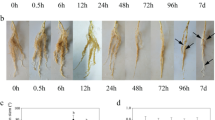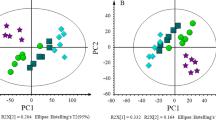Abstract
Various metabolites were analyzed in groundnut genotypes grown under varying temperature regimes (based on date of sowing). Four contrasting groundnut genotypes viz. ICGS44 (high-temperature tolerant), AK159 and GG7 (moderately-high-temperature tolerant), and DRG1 (high-temperature sensitive) were grown at three different temperature regimes i.e., low (early date of sowing), normal (normal date of sowing) and high temperature (late date of sowing) under field conditions. Untargeted metabolomic analysis of leaf tissue was performed by GC–MS, while targeted metabolite profiling was carried out by HPLC (polyamines) and UPLC-MS/MS (phenolics) at both the pegging and pod filling stages. Untargeted metabolomic profiling revealed exclusive expression/induction of beta-d-galactofuranoside, l-threonine, hexopyranose, d-glucopyranose, stearic acid, 4-ketoglucose, d-gulose, 2-o-glycerol-alpha-d-galactopyranoside and serine in ICGS44 during the pegging stage under high-temperature conditions. During the pod filling stage at higher temperature, alpha-d-galactoside, dodecanedioic acid, 1-nonadecene, 1-tetradecene and beta-d-galactofuranose were found to be higher in both ICGS44 and GG7. Moreover, almost all the metabolites detected by GC–MS were found to be higher in GG7, except beta-d-galactopyranoside, beta-d-glucopyranose, inositol and palmitic acid. Accumulation of putrescine was observed to be higher during low-temperature stress, while agmatine showed constitutive expression in all the genotypes, irrespective of temperature regime and crop growth stage. Interestingly, spermidine was observed only in the high-temperature tolerant genotype ICGS44. In our study, we found a higher accumulation of cinnamic acid, caffeic acid, salicylic acid and vanillic acid in ICGS44 compared to that of other genotypes at the pegging stage, whereas catechin and epicatechin were found during the pod filling stage in response to high-temperature stress, suggesting their probable roles in heat-stress tolerance in groundnut.






Similar content being viewed by others
Abbreviations
- dH2O:
-
Distilled water
- GC–MS:
-
Gas chromatography–mass spectrometry
- GSH:
-
Reduced glutathione
- HCL:
-
Hydrochloric acid
- HPLC:
-
High performance liquid chromatography
- MDA:
-
Malondialdehyde
- MSTFA:
-
N-Methyl-N-(trimethylsilyl) trifluoroacetamide
- MUFA:
-
Mono unsaturated fatty acid
- NaCl:
-
Sodium chloride
- NaOH:
-
Sodium hydroxide
- PLS-DA:
-
Partial least squares discriminant analysis
- PUFA:
-
Poly unsaturated fatty acid
- ROS:
-
Reactive oxygen species
- TQ:
-
Tandem quadrupole
- UPLC-MS/MS:
-
Ultra pressure liquid chromatography-tandem mass spectrometry
References
Abavisani A, Khorshidi M, Sherafatmandjour A (2013) Interaction between cold stress and polyamine on antioxidant properties in dragonhead. Int J Agri Crop Sci 5:2555–2560
Alcazar R, Cuevas JC, Planas J, Zarza X, Bortolotti C, Carrasco P, Salinas J, Tiburcio AF, Altabella T (2011) Integration of polyamines in the cold acclimation response. Plant Sci 180:31–38
An D, Yang J, Zhang P (2012) Transcriptome profiling of low temperature-treated cassava apical shoots showed dynamic responses of tropical plant to cold stress. BMC Genom 13:64
Arbona V, Manzi M, de Ollas C, Gomez-Cadenas A (2013) Metabolomics as a tool to investigate abiotic stress tolerance in plants. Int J Mol Sci 14:4885–4911
Awasthi R, Bhandari K, Nayyar H (2015) Temperature stress and redox homeostasis in agricultural crops. Front Environ Sci 3:1–24
Bita CE, Gerats T (2013) Plant tolerance to high temperature in a changing environment: scientific fundamentals and production of heat-stress tolerant crops. Front Plant Sci 4:1–18
Buchanan BB, Gruissem W, Jones RL (2000). Biochemistry and molecular biology of plants. American Society of Plant Physiologists, Rockville
Commisso M, Toffali K, Strazzer P, Stocchero M, Ceoldo S, Baldan B, Levi M, Guzzo F (2016) Impact of phenylpropanoid compounds on heat stress tolerance in carrot cell cultures. Front Plant Sci 7:1–16
Das A, Rushton PA, Rohila JS (2017) Metabolomic profiling of soybeans (Glycine max L.) reveals the importance of sugar and nitrogen metabolism under drought and heat stress. Plants 6:21. https://doi.org/10.3390/plants6020021
Djanaguiraman M, Vara Prasad PV (2014) High temperature stress. Plant genetic resources and climate change. CAB International, Wallingford
Flores HE, Galston AW (1982) Analysis of polyamines in higher plants by high performance liquid chromatography. Plant Physiol 69:701–706
Guy C, Kaplan F, Kopka J, Selbig J, Hincha DK (2008) Metabolomics of temperature stress. Physiol Plant 132:220–235
Jadhav PR, Mahatma MK, Mahatma L, Jha S, Parekh VB, Khandelwal V (2013) Expression analysis of key genes of phenylpropanoid pathway and phenol profiling during Ricinus communis-Fusarium oxysporum f. sp.ricini interaction. Ind Crop Prod 50:456–461
Janska A, Mars P, Zelenkova S, Ovesna J (2009) Cold stress and acclimation-what is important for metabolic adjustment? Plant Biol 12:395–405
Kaplan F, Kopka J, Haskell DW, Zhao W, Schiller KC, Gatzke N, Sung DY, Guy CL (2004) Exploring the temperature-stress metabolome of Arabidopsis. Plant Physiol 136:4159–4168
Koc E, Islek C, Ustun AS (2010) Effect of cold on protein, proline, phenolic compounds and chlorophyll content of two pepper (Capsicum annuum L.) varieties. Gazi Univ J Sci 23(1):1–6
Lisec J, Schauer N, Kopka J, Willmitzer L, Fernie AR (2006) Gas chromatography mass spectrometry-based metabolite profiling in plants. Nat Protoc 1(1):387–396
Liu X, Huang B (2000) Carbohydrate accumulation in relation to heat stress tolerance in two creeping bentgrass cultivars. J Am Soc Hortic Sci 125:442–447
Mahajan S, Tuteja N (2005) Cold, salinity and drought stresses: an overview. Arch Biochem Biophys 444:139–158
Mhaske SD, Mahatma MK, Jha S, Singh P, Ahmad T (2013) Polyamine metabolism and lipoxygenase activity during Fusarium oxysporum f. sp. ricini-castor interaction. Physiol Mol Biol Plants 19:323–331
Miura K, Tada Y (2014) Regulation of water, salinity, and cold stress responses by salicylic acid. Front Plant Sci 5:4
Mostofa MG, Yoshida N, Fujita M (2014) Spermidine pretreatment enhances heat tolerance in rice seedlings through modulating antioxidative and glyoxalase systems. Plant Growth Regul 73:31–44
Murkowski A (2001) Heat stress and spermidine: effect on chlorophyll fluorescence in tomato plants. Biol Plant 44(1):53–57
Nahar K, Hasanuzzaman M, Alam MM, Fujita M (2015) Exogenous spermidine alleviates low temperature injury in mung bean (Vigna radiata L.) seedlings by modulating ascorbate-glutathione and glyoxalase pathway. Int J Mol Sci 16:30117–30132
Ramakrishna A, Ravishankar GA (2011) Influence of abiotic stress signals on secondary metabolites in plants. Plant Signal Behav 6(11):1720–1731
Rivero RM. Ruiz JM, Garcia PC, López-Lefebre LR, Sánchez E, Romero L (2001) Resistance to cold and heat stress: accumulation of phenolic compounds in tomato and watermelon plants. Plant Sci 160:315–321
Sanghera GS, Wani SH, Hussain W, Singh NB (2011) Engineering cold stress tolerance in crop plants. Curr Genomics 12(1):30–43
Sanimah S, Maheswary V, Sarip J, Qistina ON, Vasanthi S (2013) Identification of phytochemicals and the associated genes in Eksotika papaya at ripening index 5 using functional genomics. J Trop Agric Fd Sci 41(2):283–308
Singh D, Balota M, Collakova E, Isleib TG, Welbaum GE, Tallury SP (2016) Heat stress related physiological and metabolic traits in peanut seedlings. Peanut Sci 43:24–35
Sugio A, Dreos R, Aparicio F, Maule AJ (2009) The cytosolic protein response as a subcomponent of the wider heat shock response in Arabidopsis. Plant Cell 21:642–654
Thind SK, Barn GK (2012) Caffeic acid and calcium application affects electrolyte leakage, hydrolases and cytosolute contents of heat stressed cotton seedlings. J Cotton Res Dev 26:77–80
Todorova D, Katerova Z, Alexieva V, Sergiev I (2015) Polyamines-possibilities for application to increase plant tolerance and adaptation capacity to stress. Genet Plant Physiol 5(2):123–144
Upchurch RG (2008) Fatty acid unsaturation, mobilization, and regulation in the response of plants to stress. Biotechnol Lett 30:967–977
Xia JC, Zhao H, Liu WZ, Li LG, He YK (2009) Role of cytokinin and salicylic acid in plant growth at low temperatures. Plant Growth Regul 57:211–221
Xia Z, Wei L, Yong X, Liu Y, Wei-song K, Xiao-dong R, Shuai Y, Yong-kuan C, Ming-ming M (2011) Comparison of different cartridges of solid phase extraction for determination of polyphenols in tobacco by UPLC/MS/MS and multivariate analysis. Chem Res Chin Univ 27(4):550–556
Xia J, Sinelnikov IV, Han B, Wishart DS (2015) MetaboAnalyst 3.0-making metabolomics more meaningful. Nucleic Acids Res 43:W251-W257
Yan-hua Z, Yu-ping Z, Jing X, Hui W, Hui-zhe C, Yi-kang Z, De-feng Z (2015) Effects of chilling tolerance induced by spermidine pretreatment on antioxidative activity, endogenous hormones and ultrastructure of indica-japonica hybrid rice seedlings. J Integr Agric. https://doi.org/10.1016/S2095-3119(15)61051-6
Zhang W, Jiang B, Song H, Li W, Yu Y, Chen J (2009) Polyamines enhance chilling tolerance of cucumber (Cucumis sativus L.) through modulating antioxidative system. Sci Hort 122:200–208
Acknowledgements
Authors are thankful to the Director, ICAR-Directorate of Groundnut Research for providing necessary field facilities to conduct this experiment.
Author information
Authors and Affiliations
Corresponding author
Electronic supplementary material
Below is the link to the electronic supplementary material.
Rights and permissions
About this article
Cite this article
Raval, S.S., Mahatma, M.K., Chakraborty, K. et al. Metabolomics of groundnut (Arachis hypogaea L.) genotypes under varying temperature regimes. Plant Growth Regul 84, 493–505 (2018). https://doi.org/10.1007/s10725-017-0356-2
Received:
Accepted:
Published:
Issue Date:
DOI: https://doi.org/10.1007/s10725-017-0356-2




